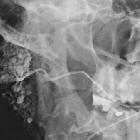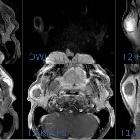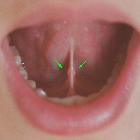sublingual gland


Imaging of
the sublingual and submandibular spaces. Anatomy of the submandibular and sublingual spaces in the coronal plane: picture illustration and T2-weighted MR image
The sublingual glands are salivary glands that lie on the floor of the mouth anterior to the submandibular glands. They secrete predominantly mucous saliva that is drained by a collection of 8-20 excretory ducts collectively termed the duct of Rivinus. The largest of these ducts, the major sublingual duct is Bartholin duct. Autonomic innervation is from the lingual nerve via the submandibular ganglion with parasympathetic fibers arising from the chorda tympani and sympathetic fibers from the facial artery.
History and etymology
Bartholin duct is named after its discoverer, the Danish anatomist Caspar Bartholin the Younger (1655-1738) .
Related pathology
Siehe auch:
- Glandula parotidea
- Tumoren der Speicheldrüsen
- duct of Rivinus
- Glandula submandibularis
- salivary glands
- ducts of the salivary glands
- major salivary glands
- submandibular ganglion
- minor salivary glands
- Caruncula sublingualis
- Hernierung der Glandula sublingualis
und weiter:

 Assoziationen und Differentialdiagnosen zu sublingual gland:
Assoziationen und Differentialdiagnosen zu sublingual gland:



